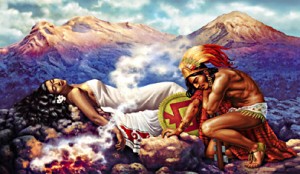The informant, J, is 18 years old born and raised in Coachella, California. His mom is from Delano, California, while his dad is from Indio, California. He is majoring in Print and Digital Journalism with a Media, Economics, and Entrepreneurship minor. He also considers himself Mexican.
J-“In Mexico city there are two volcanoes known as Popocatepetl and Iztaccihuatl. These two volcanoes have been there for as long as everyone can remember but the story behind them is what makes them special. A long time ago during the Aztecs, one of the tribes was at war with another one. At the same time, Popocatepetl, one of the tribe’s warriors, saw and fell in love with Iztaccihuatl, who was the king’s daughter. Popocatepetl asked the king for Iztaccihuatl hand in marriage if he lead the king’s army against the other tribe and defeated them. The king agreed and Popocatepetl left. Iztaccihuatl, meanwhile, was worried the whole time and was thinking about Popocatepetl and how he was doing. At the same time, one of Popocatepetl’s enemy, Tlaxcala, was jealous of his achievements and popularity. Tlaxcala decided to go to the king and tell him that Popocatepetl had lost the battle and had died. Iztaccihuatl heard the news and quickly fell into depression and into a sad death. Later on, Popocatepetl returned victorious from battle and was ready to marry Iztaccihuatl until he found out she had died. With a broken heart, Popocatepetl took her body with a torch to the top of a hill where he would weep over her body. Meanwhile, Tlaxcala, wanting to avoid the fury of the king and Popocatepetl left the tribe and traveled back to his homeland where he would soon die. The next day the tribe woke up to see two new giant volcanoes next to the tribe. One of these resembled a woman laying on the ground asleep while the other a man kneeling down looking down at the woman with smoke coming out of the top. On the other side of the tribe further away, another volcano had appeared as if it was facing the two volcanoes. The tribe realized that the two volcanoes were Iztaccihuatl and Popocatepetl. Iztaccihuatl was the sleeping woman while Popocatepetl is always active with smoke from the torch mourning the death of his loved one. The third volcano was Tlaxcala, who now had to face the two lovers for the rest of time. The volcanoes were named Iztaccihuatl, Popocatepetl, and Pico de Orizaba since its located in Orizaba”
When did you hear this story?
J-“I think it was in 3rd grade in class we learned the history of the volcanoes. Although I did not find out about the part of Tlaxcala until much later on when I was in high school”
Is this a common story in Mexico?
J-“Yes, I think pretty much everyone knows this story by word of mouth or through school”
Do you tell this story?
J-“I sometimes tell it to my friends, but I don’t really talk about. The only time I do is with my family. We like to talk about them a lot especially since we pass by them when we go and visit my family in Mexico”
Analysis- The legend has some truth in it as it incorporates real people and real tribes like the Aztecs. The part of the characters becoming volcanoes could have appeared from the traditions and beliefs of the Aztecs, who worshiped all different aspects of nature. It is clear that the country wants to maintain its traditions and culture as it teaches its students not only history but also legends and myths. It also helps create a fun and creative explanation to the children about a natural effect such as the creation of volcanoes. Even though the informant does not really talk about the legend, the fact that it is still being taught in schools means that it will not disappear.

